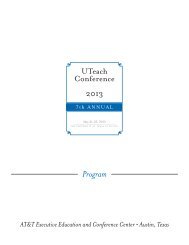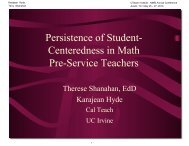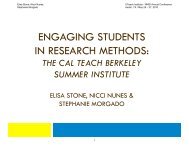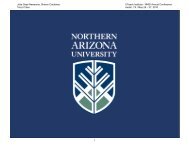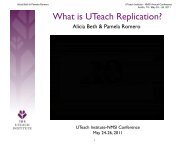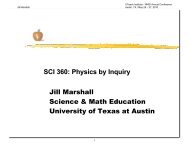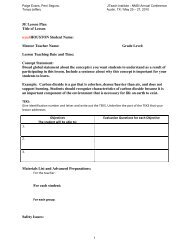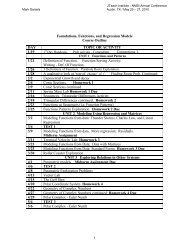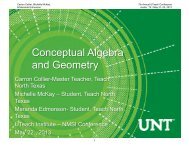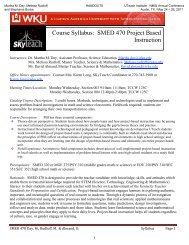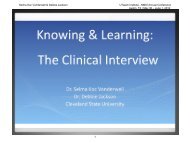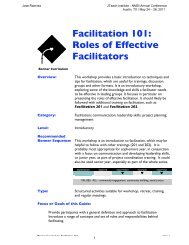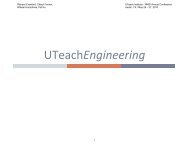Model-Eliciting Activities (MEAs) - The UTeach Institute
Model-Eliciting Activities (MEAs) - The UTeach Institute
Model-Eliciting Activities (MEAs) - The UTeach Institute
Create successful ePaper yourself
Turn your PDF publications into a flip-book with our unique Google optimized e-Paper software.
<br />
Adem Ekmekci & Gladys Krause HANDOUTS <strong>UTeach</strong> <strong>Institute</strong> - NMSI Annual Conference<br />
<br />
<br />
College Students’ Reasoning in an <br />
Optimization Problem <br />
INTRODUCTION<br />
<strong>Model</strong>-eliciting activities (<strong>MEAs</strong>) present a problem based on<br />
real-life situations to be solved by students in small groups (Lesh et.<br />
al., 2000; Zawojewski & Carmona, 2001). <strong>The</strong> activity used in this<br />
study, the Historic Hotel Problem designed by Aliprantis and<br />
Carmona (2003), is a model-eliciting activity with single numerical<br />
answer with multiple solutions (Dominguez, 2007). Through <strong>MEAs</strong><br />
students’ ways of thinking, as they work on the problem, become<br />
visible to the teacher as well as to their peers (Lesh et. al., 2000). In<br />
that sense, <strong>MEAs</strong> are thought-revealing activities in which students<br />
express their initial ideas and revise them according to feedback they<br />
get from their peers.<br />
SIGNIFICANCE<br />
Classroom practices play a crucial role in efforts to improve<br />
student learning. One of the most important steps for teachers to<br />
accomplish this goal is to know what their students know. Black &<br />
William (1998) defined classroom assessment as the activities<br />
undertaken by teachers and students to provide information about<br />
how students think and what they know. <strong>MEAs</strong> can be used and be<br />
very beneficial as a non-traditional way of classroom assessment.<br />
<strong>MEAs</strong> usually start with a newspaper article that warms student to<br />
problem statement. Readiness questions related to the article make<br />
us sure that all students are ready to the problem. Finally, problem<br />
statement emphasizes the need of a model rather than just a numeric<br />
answer. As the output of <strong>MEAs</strong>, attention should be paid to the<br />
model students develop rather than the numerical answer. That is,<br />
descriptions, explanations, constructions, and the math student use<br />
(Lesh et. al., 2000) in their models are more important than their<br />
single-numerical answer to the problem.<br />
PARTICIPANTS & THE ACTIVITY<br />
This study is an extended version of an earlier study conducted by<br />
Dominguez (2007) with an addition of 30 pre-service science and<br />
math teachers (10 groups of 3) to 94 calculus students (23 groups of<br />
4 or 5) at a university in central Texas. <strong>The</strong> activity was done in two<br />
episodes, 50-60 minutes each. In the first episode, students read the<br />
newspaper article and answered the readiness questions as a class.<br />
<strong>The</strong>n, they worked on the problem in groups.<br />
In the second episode, students completed their letters and each<br />
group presented their models to other groups and discussed their<br />
ways of solving.<br />
PROBLEM STATEMENT<br />
Mr. Frank Graham has just inherited a historic hotel with 80<br />
rooms. He is told that all of the rooms were occupied when the<br />
daily rate was $60 per room and, for every dollar increase in the<br />
daily rate, one less room is rented (if the daily rate was $61, 79<br />
rooms would be occupied). Each occupied room has a $4 cost for<br />
service and maintenance per day. Mr. Graham would like to know<br />
how much he should charge per room in order to maximize his<br />
profit, what his profit would be at that rate, and a procedure for<br />
finding the daily rate that would maximize his profit in the future<br />
even if the hotel prices and the maintenance costs change.<br />
THE PURPOSE OF THE STUDY<br />
We focused on the following questions:<br />
• What different models and optimization strategies were there?<br />
• How many college level students incorporated calculus<br />
knowledge and at what level?<br />
• Were there any difference in solution ways of calculus<br />
students and pre-service math and science teachers?<br />
• Were there any particular testing and revising cycles students<br />
went through?<br />
DATA COLLECTION<br />
All of students’ written work was analyzed and field notes were<br />
taken by researchers during the solution process.<br />
Strategy <br />
SINGLE ANSWER – MULTIPLE<br />
PERSPECTIVES<br />
Calculus groups <br />
(n=23) <br />
Adem Ekmekci <br />
Department of Science & Mathematics Education <br />
University of Texas at Austin <br />
Pre‐service Teacher <br />
Groups (n=10) <br />
Derivative 24 5 <br />
Table 1 1 <br />
Graph 1 1 <br />
Vertex formula 1 1 <br />
Historic Hotel MEA (<strong>Model</strong>‐<strong>Eliciting</strong> Activity) <br />
Total 27* 8** <br />
*3 groups gave 2 solutions and 1 group used a different strategy to verify.<br />
**<strong>The</strong> optimization strategy of 2 groups could not be identified.<br />
All calculus groups used derivative strategy, whereas 5 out of 8<br />
of pre-service teacher groups favored that method.<br />
n <br />
x <br />
y <br />
r <br />
& <br />
Austin, TX / May 24 – 26, 2011<br />
Angeles Domínguez <br />
Instituto Tecnologico de Estudios <br />
Superiores de Monterrey <br />
Functions and Variables in Students’ Solutions<br />
Definition of <br />
variables <br />
<strong>Model</strong>ing Function <br />
# of vacant P(n) = (80 ‐ n)(56 + n) <br />
rooms P(r) = (80 ‐ r)(56 + r) <br />
# of occupied P = x y ‐ 4 x & y = 140 ‐ x <br />
rooms P(x) = x (140 ‐ x) ‐ 4 x <br />
Daily rate P = x y ‐ 4 x & x = 140 ‐ y <br />
per room P(y) = y (140 ‐ y) ‐ 4 (140 ‐ y) <br />
Amount raise P(y) = (80 ‐ (y ‐ 60)) (y – 4) <br />
in daily rate P(y) = (y – 4) (140 ‐ y) <br />
Calculus <br />
Students <br />
<br />
Pre‐service <br />
Teachers <br />
20 5 <br />
2 4 <br />
2 2 <br />
2 0 <br />
Total 26* 11** <br />
*Three teams gave two solutions <br />
** One team gave two solutions <br />
<br />
Test-Revise Cycles<br />
<strong>The</strong>se are the most common testingrevising<br />
cycles emerged from students’<br />
solution process of the problem. <strong>The</strong> most<br />
common pattern was I – II – III. A few<br />
groups went through all cycles and very<br />
few groups did not use III at all: they went<br />
through I – II – IV. <strong>The</strong>se were all preservice<br />
teachers<br />
CONCLUSIONS<br />
Although it seems like there is one single-numerical answer to the<br />
Historic Hotel Problem, students used 4 different strategies for<br />
optimization. Moreover, the modeling functions students developed can<br />
be classified into four groups. From students’ written work, it was<br />
possible to see that there are multiple pathways to find a singlenumerical<br />
answer. Observing students during the modeling process<br />
made it possible to see how they went through various modeling cycles<br />
(Lesh et. al., 2000) to develop their models. Calculus students were<br />
more likely to use derivative strategy than pre-service teachers, as<br />
expected.<br />
REFERENCES:<br />
Aliprantis, C.D. & Carmona, G. (2003). Introduction to an economic problem: A <strong>Model</strong>s and <strong>Model</strong>ing Perspective. In R. Lesh & H. Doerr (Eds.), Beyond constructivism: <strong>Model</strong>s and modeling perspectives on mathematics problem solving, learning, and teaching (pp. 255-264). Mahwah, NJ: Erlbaum.<br />
Black, P. & Wiliam, D. (1998). Inside the black box: raising standards through classroom assessment. Phi Delta Kappan, October 1998, 139-148.<br />
Dominguez, A. (2007). Single solution, multiple perspectives. Proceedings of thirteenth annual meeting of <strong>The</strong> International Community of Teachers of Mathematical <strong>Model</strong>ing and Applications (ICTMA). Bloomington, IN.<br />
Lesh, R., Hoover, M., Hole, B., Kelly, E., & Post, T. (2000). Principles for developing thought revealing activities for students and teachers. In A. E. Kelly & R. A. Lesh (Eds.), Handbook of research design in mathematics and science education (pp. 591-645). Mahaway, NJ: Lawrence Erlbaum.<br />
Zawojewski, J., & Carmona, G. (2001). A developmental and social perspective on problem solving strategies. In R. Speiser & C. Walter (Eds.), Proceedings of the twenty-third annual meeting of the north American chapter of the international group for the psychology of mathematicseducation.<br />
Columbus, OH: ERIC Clearinghouse for Science, Mathematics, and Environmental Education.<br />
3



